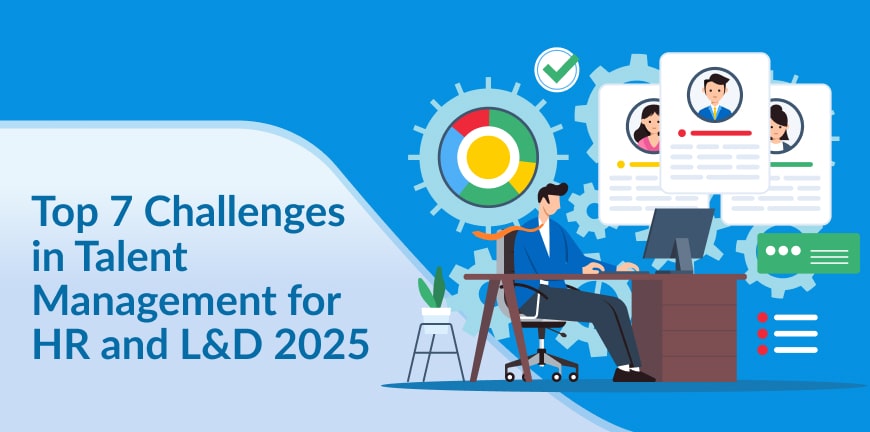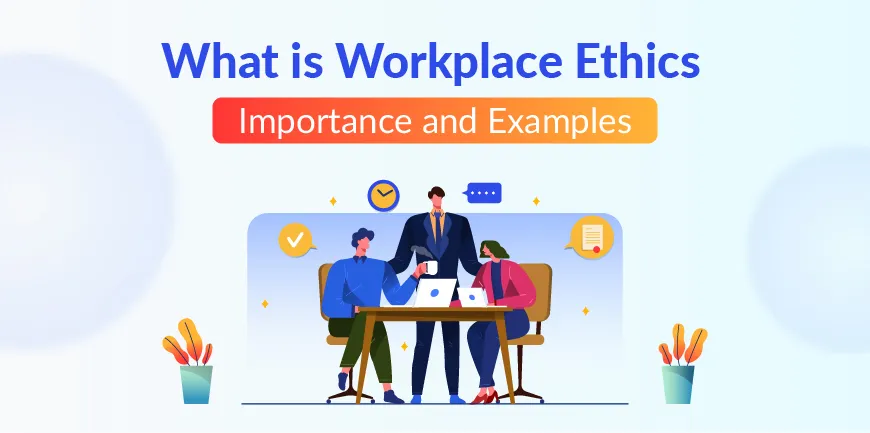
Attracting and Retaining Gen Z Talent in the Manufacturing Sector
17/04/2025
Pros and Cons of Staff Augmentation: A Complete Guide
17/04/2025For companies, finding and acquiring top talent has always been challenging. But that is not where the problem ends. Another hurdle they must dodge even if they do find their desired talent, is addressing the challenges of talent management, which is engaging them, developing their skills, preparing them to be AI ready to help meet organizational goals.
According to a study by McKinsey, 87% of CEOs revealed they are or will be facing major skill gap challenges in their organizations. Effectively upskilling them, managing them and monitoring their growth is the need of the hour. This makes talent management extremely crucial for a company’s success.
What is Talent Management?
Talent Management is a process that involves attracting, training, engaging, and retaining employees to ensure that their skills and expertise align with the organization’s goals. It is a strategic approach that ensures the management of the entire lifecycle of an employee right from hiring to exit, making sure the organization’s top talent is present at the right time to achieve business goals and objectives.
What is the Importance of Talent Management?
Understanding and implementation of the best practices of talent management is not just rewarding for the HR but also the organization overall. Here are some of the reasons why talent management is important-
- Retaining top talent can help enhance your company’s performance and realise any organizational goal.
- Top performing employees have the skills and capabilities to solve complex problems using modern tools and techniques.
- Higher overall productivity is easier to achieve in teams as every team member is trained to work at their maximum potential to achieve a common goal.
- Using the hiring process, you can help uncover potentially vacant roles in the company and ensure that there are highly qualified employees to achieve business goals.
- Talent management also ensures that your employees have a workload they can easily manage.
Top 7 Challenges in Talent Management
Here are some of the major challenges in talent management across various industries and the results of failure in managing talent effectively.
1. Evaluation of skill gaps
One of the biggest talent management challenges for HR is correctly assessing and evaluating skill gaps in an organization. And unfortunately, there are not any sure shot ways for the HR to rigorously evaluate skills. And not being able to evaluate skills makes it hard for organizations to create employee L&D programs to match their business needs.
This can lead to a major drop in productivity. However, there are a few measurement tools that can assess standardized skills effectively and help firms get real-time information about the skills of employees. HR teams can proactively address skills gaps and align training initiatives with strategic business objectives.
2. Failure to track skill development of employees
Many times, while organizations keep track of how their employees are learning they fail to monitor their skill development over time. Studies have shown that an exceedingly small percentage of learning and development programs are successful. This shows the importance of tracking the results in real time from L&D programs.
How? Organizations must be ready to invest in measuring and progress monitoring tools that can track skill development of employees continuously. This data-driven method can give HR a better idea of how the training programs is working enabling organizations reap the best out of their investment on the L&D programs.
3. Language barriers preventing discussion of skills
Not having a uniform language for describing abilities in talent management creates a gap of communication between HR, employees, and the management. When there is no proper discussion as to how and where an employee’s particular skill can be put to use, there can be an obstruction in alignment of talent strategies with organizational goals.
As per a Deloitte survey, only 10% of HR executives possess a well-defined skills taxonomy or framework. But even in the 10%, there is no in-depth record of the skills, which makes it hard to take the right decisions about where to allocate the talent and how to develop them.
By classifying these skills properly, the communication gap can be eliminated and make way for effective discussions on skills.
4. Skills matching with job requirements
Matching candidates with the right skills with the right job is extremely crucial for a company’s success as well as employee satisfaction. Failure to do so leads to disengagement at work and less productivity. This will also remain as one of the future challenges of talent management, given the number of new jobs being added and the failure to match candidates with the right skills for these jobs.
To ensure this does not happen, organizations must use a skills-based method of talent management helping both the job seekers as well as the employer with the right fit. Not only will this boost job satisfaction but also help organizations navigate the job market effectively resulting better results in terms of achieving their organizational goals.
5. Having an inclusive talent management framework
Having an inclusive talent management framework is much more than just having the right policies. It is about building a workplace where every employee is treated equally in terms of giving chances and growth opportunities.
While organizations have been taking steps to eliminate unconscious bias, other aspects like performance reviews, promotions and learning opportunities still favour some employees over the others. Organizations lose talent who are deserving of opportunities leading to less innovation and damage of brand reputation.
Creating clear career pathways, objective performance criteria, and leadership accountability can help address this problem. AI-powered tools can help by flagging biases, tracking diversity metrics, and ensuring career development is based on verified skills rather than subjective evaluations.
6. Reconceptualize roles of managers
Managers are overwhelmed with responsibility in most organizations. According to Gartner’s 2025 HR priorities survey, 75% of HR leaders know that managers are not able to manage the workload while 70% can see that the leadership programs are not helping managers.
Managers are being overburdened with too many other things that they are not finding the time to have performance conversations or for professional development planning. This leads to the suffering of team members as well as they do not get the attention of their manager as often as they need it.
With better training, clearer expectations and lesser administrative burden, managers can find the time for things that matter. AI-driven performance management tools can support this by prompting check-ins, surfacing real-time performance insights, and coaching them to provide more actionable, effective feedback.
7. Normalize hybrid work models
Post the pandemic, most employees are not very happy with the return to office policies, and this is costing organizations their most valuable employees. While it is not wrong for leaders to expect employees to return to office for better collaboration and build a strong company culture, employees are now used to having flexibility with their work arrangements.
Rigid RTO policies can lead to weaker engagement, higher turnover and in the long-term difficulties in attracting top talent.
Organizations must ensure consistent, outcome driven policies where employees’ expectations are managed as well as organisational goals are achieved. Managers can be trained to track productivity, collaboration, and engagement metrics rather than time spent in an office.
Best Practices to Tackle Talent Management
Organizations must implement certain strategies to overcome the challenges faced in talent management. Here are some of the best practices for effective talent management-
- Conduct proper job analysis by using the right job postings, diverse sourcing channels and customized interview processes. This can help organizations acquire candidates with skills that align with the organizational goals leading to better talent management.
- HR must utilize technology like ATS for candidate screening, scheduling of interviews, setting up online training modules, enabling real time feedback and personalized development plans for performance management.
- Identify high performing employees and offer them mentorship, better assignments and more. To retain these employees, recognize and reward their efforts and achievements, encourage open communication, and address their concerns.
- Offer attractive compensation and benefits based on of course the market analysis. Build a culture of engagement and foster a learning environment to keep the productivity going.
In 2025, HR and L&D leaders are having to adapt to many changes like employee expectations, technological advancements. From attracting and retaining top talent to building future-ready skills and fostering inclusive cultures, the challenges of talent management have become much more complex.
By leveraging data-driven insights, and aligning talent strategies with broader organizational goals, HR and L&D teams can turn these challenges into competitive advantages. The way we manage talent today will define the success of our organizations tomorrow. Organizations can become more competitive by managing their employees better.
Frequently Asked Questions (FAQs)
1. What are the issues and challenges in the talent management area?
Some of the major talent management challenges in the talent management area include- talent acquisition, engaging and retaining top talent, supporting learning and development programs, inclusiveness in talent management, supporting hybrid work models.
2. What are the challenges of global talent management?
Some of the key challenges of global talent management include managing cultural differences, navigating legal complexities in diverse jurisdictions, overcoming language barriers, and ensuring talent retention across borders. Additionally, identifying and attracting skilled employees in global markets, adapting to evolving workforce demographics, and ensuring legal compliance in various regions are all key challenges.
3. What is Talent Management?
Talent Management is a process that involves attracting, training, engaging, and retaining employees to ensure that their skills and expertise align with the organization’s goals. It is a strategic approach that ensures the management of the entire lifecycle of an employee right from hiring to exit, making sure the organization’s top talent is present at the right time to achieve business goals and objectives.
4. What strategies must be used to overcome the challenges in talent management?
Some of the strategies that can be used to address talent management challenges are to drive goal alignment and determine metrics, create a strong employer brand, focus on employee experience, encourage a high-performance culture, gain a single-source view of employees.
5. What are the benefits and challenges of talent management?
While there are many benefits of talent management like improved business performance, drive innovation, decreased turnover, companies can stay competitive etc there are also some challenges like finding and hiring the right talent, address skill gaps effectively and managing diverse workforce needs.
Contact Us For Business Enquiry

Rajkumar Shanmugam
Rajkumar Shanmugam is the Head of HR at ALP Consulting, bringing over 19 years of comprehensive HR leadership experience across India and international markets. His expertise spans talent acquisition, employee relations, performance management, compliance, and HR transformation. Rajkumar has a proven track record of driving people-centric initiatives, enhancing workplace culture, and aligning HR strategy with business goals. With extensive experience in US staffing operations and global mobility, he continues to lead organizational excellence through innovation and employee engagement.




